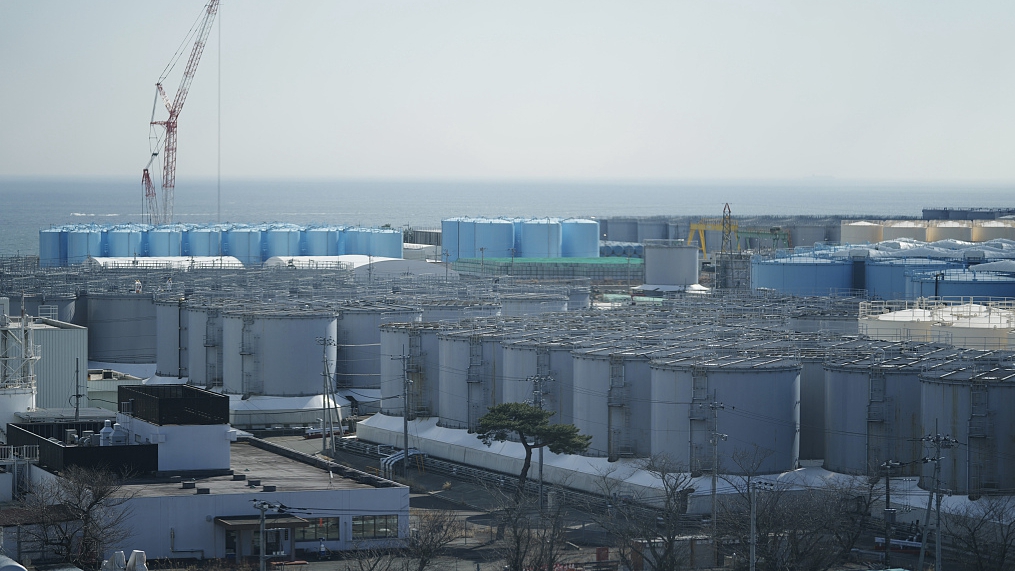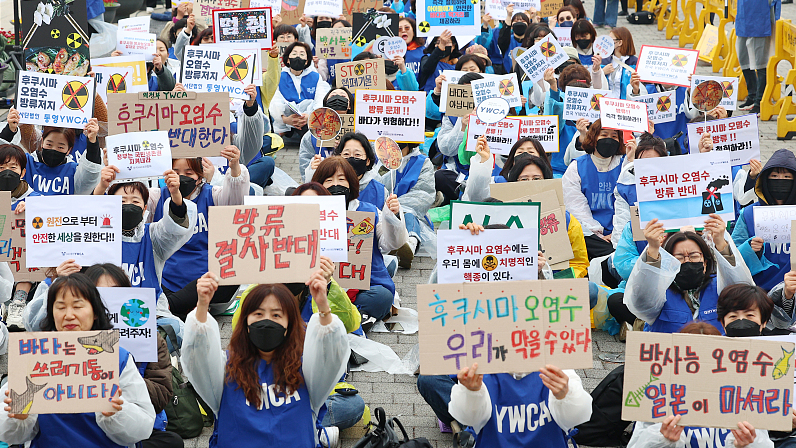Japan began trial operation of a facility that discharges the nuclear-contaminated wastewater into the ocean from the crippled Fukushima Daiichi nuclear power plant on Monday, which will last 10 days to two weeks.
Japan is likely to officially begin its plan to dump the wastewater into the ocean as early as the beginning of July. The implementation of Japan's plan still needs to await the outcome of the International Atomic Energy Agency's (IAEA) meeting in late June.

The Fukushima Daiichi nuclear power plant in Japan, March 17, 2022. /CFP
The Fukushima Daiichi nuclear power plant in Japan, March 17, 2022. /CFP
As of June 2, Tokyo Electric Power Company (TEPCO), the plant's operator, has installed roughly 1,000 special tanks at the plant site to hold around 1.3 million cubic meters of treated water. As the storage space is about to run out, TEPCO has been rushing to dump the wastewater into the ocean.
Japanese officials said the wastewater will be treated to legally releasable levels and further diluted with large amounts of seawater, making it harmless to people and marine life.
However, the lack of transparency of the Japanese government in disclosing wastewater discharge makes its claims unconvincing.

The Fukushima Daiichi nuclear power plant run by TEPCO, Japan, March 3, 2022. /CFP
The Fukushima Daiichi nuclear power plant run by TEPCO, Japan, March 3, 2022. /CFP
At first, TEPCO said tritium, a radioactive form of hydrogen, is the only substance that cannot be removed from the wastewater. But the facts contradict its claims.
In 2018, it's reported that TEPCO had not revealed that the treated water included other radionuclides, such as strontium-90 and iodine-129, at higher concentrations than the regulatory standards, despite saying for years they had been removed. Also, TEPCO admitted carbon-14, a radioactive material, cannot be removed.
As the first round of wastewater filtration treatment was not effective, TEPCO in 2020 decided to conduct a secondary treatment before discharge.
However, before Japan dumped the wastewater, a statement released by the Chinese embassy in Japan on June 5, referring to data from a report released by TEPCO, showed that the content of Cs-137 (a radioactive element that is a common byproduct in nuclear reactors) in the marine fish caught in the harbor of the plant is 180 times that of the standard maximum stipulated in Japan's food safety law.
It also pointed out that there are more than 60 radionuclides, including tritium, carbon-14, cobalt-60, strontium-90 and iodine-129, in the nuclear-contaminated water.
In fact, the multi-nuclide removal system that TEPCO adopts, the Advanced Liquid Processing System (ALPS) also experienced several severe problems during operation.
In 2016, the system was found to be leaking. In 2021, the filters in ALPS were found to be damaged, and radioactive contamination had been detected near some of the filters.

People rally in front of the Yongsan Presidential Office in Seoul, South Korea, to urge Japan not to discharge the treated wastewater from the Fukushima nuclear plant into the sea, April 6, 2023. /CFP
People rally in front of the Yongsan Presidential Office in Seoul, South Korea, to urge Japan not to discharge the treated wastewater from the Fukushima nuclear plant into the sea, April 6, 2023. /CFP
In the face of international doubts about the safety of the wastewater, Japan insists that the purified "treated water" is no different from the normal discharged water from a nuclear power plant.
Li Song, China's Permanent Representative to the UN and other international organizations at an IAEA board of governors meeting held on Monday in Vienna pointed out that Japan has adjusted the concept that the discharge of nuclear-contaminated wastewater from Fukushima into the sea, which is completely different from the normal operation of nuclear power plants.
The so-called treated nuclear wastewater that Japan insists on refers to the wastewater produced by a nuclear power plant during normal operation and the water does not come into contact with radioactive materials in nuclear reactors, while the Fukushima nuclear-contaminated wastewater came into direct contact with radioactive materials during the accident and is highly radioactive, which must be strictly stored and treated by multiple processes and evaluated by experts before it is allowed to be discharged.
Some scientists say the impact of long-term, low-dose exposure to radionuclides is unknown and the release should be delayed.
"Any nuclear-contaminated water containing radioactive materials has the potential to harm marine life, the marine environment and ultimately human health," said Shaun Burnie, a senior nuclear specialist at Greenpeace, in an interview. "The research of the possible long-term consequences of each different radioactive element in the nuclear-contaminated water is needed,", he added.
(If you have specific expertise and want to contribute, or if you have a topic of interest that you'd like to share with us, please email us at nature@cgtn.com.)